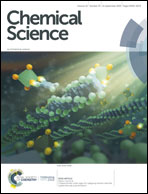Metal-free perovskites for non linear optical materials†
Abstract
We identify the existence of non linear optical (NLO) activity in a number of novel ABX3-type metal-free perovskites, where A is a highly tuneable organic cation, B is a NH4 cation and X is a halide anion. Through systematic first-principles calculations, we identify important trends to chart the second-harmonic generation of this class of materials. We study three perovskites MDABCO–NH4I3, CNDABCO–NH4I3 and ODABCO–NH4I3 for use as deep-UV second-harmonic generation materials. We identify the role of the dipole moment imparted by the organic group on the A cation as an important parameter to tune the NLO properties of these materials. We apply this knowledge functionalising the organic group DABCO with the highly polar cyanide CN− group, and we demonstrate a significant improvement of the NLO response in this family of materials. These findings can accelerate the application of metalfree perovskites as inexpensive, non-toxic, earth-abundant materials for the next generation of optical communication applications.

- This article is part of the themed collections: Perovskites march on and The ChemRxiv Collection


 Please wait while we load your content...
Please wait while we load your content...